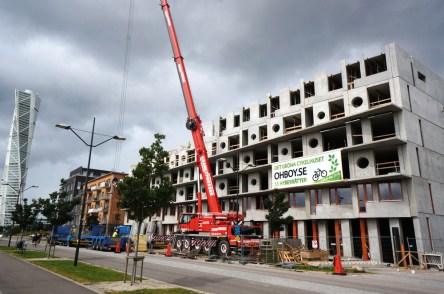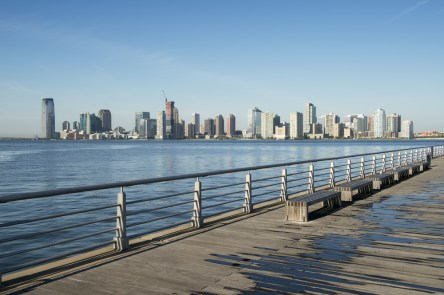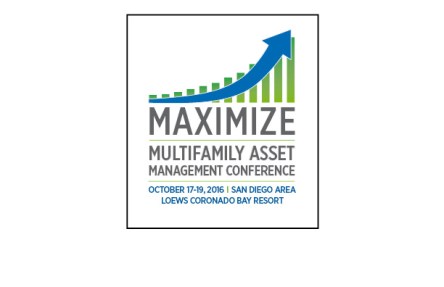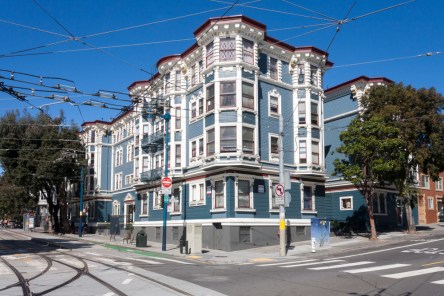Before the presidential election, the consensus economic forecast was more of the same slow-growth environment that has prevailed since the Great Recession ended. However, the election of Donald Trump changed expectations for domestic output, prompting interest rates to rise. Yardi Matrix vice president Jeff Adler and CBRE Americas head of research Jeanette Rice spoke to these changes and more during the Apartment Markets: The Macro Perspective panel at the National Multifamily Housing Council’s recent Apartment Strategies Outlook Conference. The panelists discussed what rising interest rates could mean for an interest-rate sensitive asset class such as commercial real estate. Adler asserted that the impact will be determined by how much and how fast rates increase and property performance. A prolonged period of rising rates could diminish property valuations, but at the same time a modest decline in values caused by a one-time bump in rates could be offset with revenue increases. Although it will take some time before the true impacts can be fully gauged, if interest rates are an indication, then economic productivity and inflation could rise in the coming years. The panelists deliberated upon what happens to cap rates as interest rates and (by extension) property values move higher. Adler believes that Cap rates are likely to moderately rise and valuations may take a slight hit as interest rates increase, however the key factors will be the pace of rate increases and the concurrent revenue growth. He shared a model that Yardi Matrix® created to predict the impact of both interest rate and revenue increases and determined that mild and steady interest rate increases can be significantly offset by healthy revenue growth, and as a result valuations should remain stable. Looking at an internal rate of return (IRR) calculation, an increase in interest...
Marketing to Boomers
Tips for Multifamily Firms
Did you know that Baby Boomers are the second largest demographic in multifamily housing? Most companies only spend five percent of their advertising budget (and even less effort) on this growing group. Don’t be like them. We’ve got eight tips to master online marketing to Baby Boomers. State your cost—clearly—and why your property is worth it. This fundamental tip is especially relevant to Boomers. They have a lot of money to invest in companies that meet their needs. According to this Nielsen report, Boomers currently control about 70 percent of all disposable income in the US. In the next 20 years, they are set to inherit $13 trillion more. If your property meets their needs, they won’t need sales tricks to buy in. Ensure that your marketing story explains how your property can meet and exceed their expectations. They will be willing to pay top dollar. Highlight the conveniences of renting. Many Boomers opt to rent so that they can explore other interests without the burdens of homeownership. The amenities that set your rentals apart from homeownership are valuable selling features. As former homeowners, many Boomers know that property maintenance is hard work. Boomers will appreciate the assurance of prompt maintenance services. Highlight residents’ access to Online Maintenance Requests through Yardi RentCafe®. The tool will appeal to their desire for convenience. Tell the story of the active, hip Boomer. Boomers don’t want to be reminded that they’re aging. This generation focuses on an active lifestyle and exploring new interests. Feature local hiking trails, parks, and your community fitness classes on your website and social media. Let them envision living the lifestyle that they crave while in your community. Note that Boomers not done living it up. While some are caregivers and part-time babysitters for...
Multifamily Outlook
Yardi Matrix Looks At 2017
The multifamily market has seen phenomenal growth in rents and property values for several years. Can the good times continue to roll in 2017? We think they can, though the rate of rent increases is going to slow down, transaction yields have likely bottomed and oversupply is going to negatively impact some markets. However, we expect that the multifamily market will continue to enjoy positive fundamentals. The biggest factor is that demand for multifamily is poised to remain robust for years, maybe as much as a decade. The number of Millennials between the prime renter ages of 20 and 34 is projected to increase by two million before it peaks at almost 70 million in 2024. That coincides with a bump in the number of white, college-educated renters relocating to urban areas for the “18-hour” city lifestyle that includes entertainment and access to public transportation. As the young worker pool grows, unemployment rates have dipped below 5 percent and wage growth has intensified, hitting 2.8 percent year-over-year as of October 2016. The result is a boom in household formations, which have steadily risen since slumping badly in the wake of the last recession. A further reason for optimism is that new supply has not kept up with the surge in multifamily households. The number of renter households increased by 9.3 million in the 10 years between 2005 and 2015, according to the Census Bureau, while the number of owner-occupied households dropped by 2.1 million. The result is that occupancies of stabilized properties are near all-time highs, at 95.8 percent nationally as of October, according to Yardi Matrix. Even though supply has rebounded from the recessionary lows—Yardi Matrix forecasts about 350,000 units to come online in the U.S. in 2017—that is barely enough to match...
Drive More Traffic
To Property Websites
Remember when property marketing was all about foot traffic? Not anymore. In this digital era, an increasing number of apartment seekers start their search online, long before they ever set foot in your leasing office. And the most recent NMHC Kingsley Renter Preferences Study showed that 80% of renters visited the community or company wesite during their apartment search. As a savvy property manager, you already know that online is the name of the game. And you’ve got a website for your property. But how do you get people to visit it? Not everyone has the budget or staff for paid search ads. Fortunately, that’s not the only answer. Here are three inexpensive things you can do to drive more traffic to your property websites. Go Mobile First things first, you can’t get traffic if it can’t find you. Not only is a mobile-friendly website important for easy viewing from a phone, it’s also critical to help your site get found during mobile searches. In fact, did you hear about “Mobilegeddon” in April 2015? This was when Google updated its algorithm so that only responsive websites appeared in mobile search results. A lot of US businesses lost search traffic because they weren’t mobile friendly. Don’t let that happen to you! First, update your website to a responsive design that works on any size screen to make sure it appears in all search results. Then be sure to include important details that mobile searchers may be looking for near the top of the page. Give them easy access to your phone number, office hours and vacancies. Brand Everything Your property website is one of your most powerful marketing tools. Are you using it to your full advantage? It’s time to put your website address on...
Resident Screening
Results for Banyan Living
Amanda Smeltzer, executive director at Banyan Living, reports, “Yardi Resident Screening streamlines our screening process with easy to read reports and automatic renter approvals. The solution makes life easy for our staff, while it provides convenience for our customers.” As part of our mission to keep delivering solutions that help our Yardi clients succeed, enhancements to the popular Yardi Resident Screening module were recently released. Clients already know that approving quality residents automatically as part of their leasing workflow with Yardi Resident Screening saves time and money. Now, the system includes even more features to help clients not only easily select low risk residents who improve their bottom line, but also get more detailed analytics about individual applicants, local area renters and overall property performance. Single sign-on and better UI: now with a single sign-on from Yardi Voyager, a fully responsive UI and an enhanced Executive Dashboard, clients can work more quickly, access needed data instantly and navigate the entire system with greater ease. Fee Manager functionality: a new “fee manager” compatibility feature conveniently shows all of a fee manager’s Yardi Resident Screening analytics under one account, even if they operate from multiple owners’ Voyager databases. Criminal conviction details and improved accuracy: when an applicant is rejected based on the criminal background check, the system now provides detail about the type of conviction(s) that resulted in the rejection. And to continue to ensure and improve accuracy, applicant middle names will be required for all screenings starting in early 2017. New reports and deeper insight: to make the daily lives of property managers and owners easier than ever, more reports are available, and a new property performance feature provides a snapshot of application volume and demographic information. And to discover which local employers provide the...
Affordability Crisis
Toolkit for Development
While the ghosts of the last decade’s housing crisis have (mostly) been put to rest, for many families priced out of their local markets the need for affordable housing remains strong. Like the PC’s infamous “blue screen of death,” the Urban Institute’s map of affordable housing inventory is terrifying to behold. A handful of dark blue swatches in Midwest represent healthy levels of affordable housing inventory. The rest of the country, on the other hand, sits awash in the lightest indigo hues. From barely perceptible azure to the palest cerulean, a majority of states contain less than 50 units per 100 extremely low-income households. More than a third sit at, or close, to zero. As demand for budget-friendly rentals continues to rise, many communities struggle to provide adequate supply. In response to this affordable housing crisis, the White House recently released the Housing Development Toolkit. Part call to action, part policy overhaul, the toolkit’s main purpose it to help cities increase their affordable housing inventory. “The growing severity of unsupplied housing markets is jeopardizing housing affordability for working families,” write the toolkit’s authors, “increasing income inequality by reducing less-skilled workers’ access to high-wage labor markets, and stifling GDP growth by driving labor migration away from the most productive regions,” Accumulated Barriers While New York City’s real estate market is the stuff of legend, until recently most cities were able to supply adequate housing to residents. Unfortunately, several factors have conspired over the last few years to shrink stock and ramp up costs. These “accumulated barriers” are identified by the toolkit as lack of adequate construction, high job growth in areas with low vacancy rates, gentrification, and cost-per-unit increases paired with insufficient public assistance. “The accumulation of these barriers has reduced the ability of many housing markets to...
Smart Renters
Want Smart Energy
Rising utility costs are a growing concern for renters. A recent report by Freddie Mac suggests that increasing utility costs concern renters more than rising rents—and renters are willing to pay higher rents for greener units. Forbes reports that the price of every energy commodity included in its index declined in the double digits since 2013. Electricity was the only exception with a decline of 0.4 percent. Energy costs are lower yet residents receive higher bills even when demand and usage have not increased. The changes are so alarming that concerns over rising utility costs now outweigh worries over rising rents. The “Profile of Today’s Renter” by Freddie Mac reveals that 70 percent of respondents are moderately to greatly concerned about higher utility bills. More than 60 percent share the same level of concern about potential rent increases. Utilities and rents are neck-in-neck when renters consider the impact on their budgets. Of participants, 74 percent report that higher utility bills will have a great impact or some impact on their household finances. In comparison, 78 percent express similar views about higher rents. What may come as a surprise is that 47 percent of renters are willing to pay higher rents for a unit that promotes energy conservation. Of those surveyed, 88 percent say that green multifamily properties will help to reduce their utility expenses. But that’s not the only reason why renters will invest more in a green apartment. The perceived and actual value of sustainable properties extends beyond renters’ utility bills. A remarkable 84 percent of renters believe that multifamily properties that invest in sustainable features are “better places to live.” For many, energy conservation is a logical, ethical, and moral preference. Yardi Smart Energy Suite for multifamily properties addresses renters’ concerns by...
Pedal Power
Bike Apartments
In bike-friendly Sweden, a new apartment complex includes custom design elements aimed at encouraging residents to ditch cars in favor of pedal power. For many urban apartment dwellers, parking spots and constant traffic severely undercut the benefits of living within the city limits. Sure, public transportation, walking, and cycling are all reasonable alternatives to private automobiles, but sometimes the hassles outweigh the benefits. In Malmö, Sweden, a new apartment complex is ditching carports for bike racks in the hopes that future tenants will embrace a car-free existence. “It’s a perfect city for biking,” says Cykelhuset Ohboy spokesperson Ellen Mendel-Hartvig. “It’s super flat, and you can get anywhere within 15 minutes.” Centrally Cycling Located just minutes from the city center, Cykelhuset Ohboy, a 7-story bicycle house/hotel, is an easy trek by foot or bike from major shopping districts and even the central train station. Large delivery mailboxes will help resident shop online for items that might be too difficult to transport without a car, though the building’s fleet of cargo-bikes will also help with heavy loads and even help parents transport their children to school or daycare. “The strategy is to look at why people have to use cars, and substitute bikes, “Cord Siegel, one of the architects at Hauschild + Siegel, which designed Cykelhuset Ohboy, tells Fast Company in a recent interview. The Un-Motor Lodge In addition to 55 one to four-bedroom units, Cykelhuset Ohboy will also double as a hotel, with 31 lofts available for nightly rentals. Available for shorter tenancies – a few weeks to a month or two, the 237-sqft lofts include a small kitchen and can sleep up to three people. In a play on the traditional “motor-lodge,” guests will be able to ride their bike right up to their...
Market Forecast
Yardi experts weigh in
Jeff Adler and Jack Kern hosted the semi-annual Yardi Matrix webinar on Thursday, November 10th. More than 300 participants dialed in to hear their data-based assessment of the economy and the multifamily market. Our hosts covered a number of topics from the 2016 presidential election, to job growth and economic fundamentals, to specific markets and submarkets primed for growth in the coming years. .Highlights of the webinar included: Economic Fundamentals: The domestic economy continues to grow at a steady pace, creating new jobs at an average rate between 150,000 and 200,000 per month. Recent GDP growth shows signs of strength as output picked up in the third quarter, yet the economy has cooled slightly compared to prior years. Strong employment and modestly rising wages have supported the American consumer, which in turn has helped bolster the economy. Inflation remains tepid although, as Adler mentioned, there are two sides of the inflation equation. Goods inflation has remained flat and even negative at times, while services inflation, specifically education, rent and healthcare, has been rising significantly. The State of the Multifamily Market: New apartment construction has been a major headline throughout 2016 and Yardi Matrix anticipates roughly 350,000 new units to be completed this year. While 2016 will be the largest year for new supply since the Great Recession, Adler noted that the majority of new supply is being built in only 10 markets across the country. As a result, certain high supply markets such as San Francisco, Houston, and Denver have seen rents decelerate throughout the second half of the year, while rent growth remains above 5% in many markets across the country, especially on the west coast. Demand remains strong and Adler indicated that pent up demand, especially among millennials, should provide a consistent...
Purposeful Surveys
Using Resident Response Data
You’ve probably heard the saying, “You can’t manage what you haven’t measured.” What exactly do you do once resident satisfaction has been measured? The data within your resident survey results can pave the road for a more profitable and enjoyable property—if you optimize use of the data. Make a Plan Before you issue the survey, get team leaders onboard with the process. When leaders are vested in the survey, they will provide enthusiasm, structure and accountability among staff members. Enthusiasm for surveys may be hard to muster. If your leadership sees surveys as a public roast, they are less inclined to throw themselves on the chopping block. The first step is to change the way that the staff sees surveys. Kristin Van Ramshorst, Social Media Specialist at Yardi, encourages clients to see all feedback as good feedback. “Any feedback – positive, negative, or in between – is good feedback and a way to offer better customer service,” says Van Ramshorst. “Respond to negative feedback in a way that is timely, empathetic and identifies solutions. Often times responding in a timely manner can also deescalate complex resident complaints and take the conversation offline faster.” Your plan may also include a strategy for compensation and responsibility dissemination. Consider: Will your property have specific hours for responding to issues brought up in the surveys? How will your staff be compensated for responding outside of normal business hours? Outside of normal business hours, are auto-response messages (i.e. Facebook Messenger) a good option for your property? If there are technical or legal issues reported in a complaint, which individuals at your company or corporate will you escalate the inquiry to? What resources (i.e. training, staff, equipment) do you currently have available at your property to respond to social...
Package Prep
Drones, Lockers and More
From smart lockers to drone landing pads, multifamily prepares for the quickly evolving future o f e-commerce and deliveries. Alan Gershenhorn, chief commercial officer at UPS, reviewed the latest online sales data during a panel discussion with the National Multihousing Council: Brick-and-mortar retail has grown at approximately 2 percent each year. In comparison, e-commerce has grown in the teens. In 2015, online sales grew by 14.6 percent according to the U.S. Department of Commerce. Nearly half of UPS deliveries go to residences, continues Gershenhorn. As delivery quantities increase, multifamily leadership faces a series of challenges. Currently, delivered packages sit at the threshold of the residence where it is exposed to damage from the elements and at risk of theft. A missing package reflects poorly on the community and resident satisfaction scores. Within some multifamily communities, the package is delivered to the leasing office staff or concierge. This method poses an additional burden to staff members that are now accountable for the package. Staff must have adequate space to store the parcels, which can be anything from a tiny jewelry box to furniture and appliances. The staff must also find favorable conditions in which to store the packages. Food delivery and other perishable items require climate control. Multifamily leaders eagerly explore cost-effective solutions to their delivery and storage challenges. The ideal solution would offer security, flexible space, and perhaps even a degree of insulation. In terms of costs, having residents handle their own packages is a clear choice. The courier industry offers several self-serve options that limit the accountability of multifamily staff: UPS My Choice and FedEx Delivery Manager allow users to determine their delivery preferences, such as time and date. Users receive notifications of the package’s progress. UPS Access Point program relies on third-party...
Bracing for Impact
Recession Proofing Tips
Economic forecasts can seem as mysterious as reading tea leaves or interpreting the energy of a crystal ball. Hit or miss at best. Yet with several economists spotting a recession on the horizon, property managers may want to take precautions. The U.S. Bureau of Labor Statistics kicked off the summer with a wave of bad news. Only 38,000 nonfarm jobs were created in the previous month—122,000 fewer than many economists expected. World economies are tottering on the brink of a slump. Washington Times points to the misallocation of credit as a catalyst for economic decline. Policies created by the Fed, Bank of Japan, and European Center bank subsidize government debt rather than funneling that support to job-generating small business. Additional financial, labor, and economic policies muddy up the economic waters. The end results may be stagnant or weakening economies throughout North America, Europe and Asia. The bottom line: the next 12 months may bring another economic decline. JP Morgan cites the U.S. as a “medium-term recession risk.” If there is a decline, it’s too early to determine its severity. Property managers can brace for impact of any caliber with these stabilizing tips: Be selective. Now is the time to be picky about your tenants. In depth screening processes will help property managers identify tenants who pose the least amount of risk. Collect now. Reconcile late payments and balance the books. Position the business in the best financial state possible and maintain that balance. Clean house. Replace problematic tenants with more reliable candidates while the market is still favorable. Appear occupied. If your space is currently vacant, outsiders should not be able to tell. Properties that show signs of neglect are a turn off for property hunters. In contrast, neglected properties are very appealing to...
Airbnb + Apartments
Working out the Kinks
Airbnb announced the official launch of its multifamily housing program. The Friendly Buildings Program welcomes collaboration with apartment owners and addresses their apprehensions regarding transparency and accountability—that is what it attempts to do, at least. Nearly 35 percent of multifamily property owners are interested in a home-sharing program and 24 percent of owners were unsure, reports the new National Multifamily Housing Council (NMHC) home-sharing survey. Nearly 60 percent of multifamily property owners are open to the idea of Airbnb onsite. The market is a powerful growth opportunity for the company if it can overcome owners’ concerns. In the past, apartment owners routinely resisted the use of their properties for short-term rentals. The legalities of renter subleasing and inadequate insurance provisions topped the list of objections. Security and accountability trailed close behind. The Friendly Buildings Program proposes the following solutions: The program brings property owners into the loop of transactions. Owners can establish parameters for unit-sharing, including restrictions. Short-term rental provisions are made easy through lease addendums. Owners are notified of home sharing activity including reservation details and guest information. Owners receive regularly scheduled activity reports. The program protects against liability claims up to $1 million USD that occur in a listing as well as up to $1 million against third party claims of property damage or bodily injury. Kim Duty, Senior VP, Public Affairs & Industry Initiatives at NMHC summarized many owners’ thoughts on the insurance proposal, “A $1 million insurance policy is not close to enough to cover the potential risks.” Until more can be done to reduce liability, Airbnb faces a formidable obstacle. Most owners won’t move forward without a feasible insurance solution. Mark Stringer, executive Vice President at Avenue5 Residential took a quick survey of the room. More than 75 percent of...
Roscoe Properties
Solutions for Growth + Efficiency
The semi-annual Yardi Advanced Solutions Conferences (YASC) take place on the West and East Coasts, providing clients with the opportunity to attend an event close to home. Each conference offers specialized courses on product features, networking opportunities, and one-on-one consultations with Yardi representatives. At YASC in Washington, D.C., Yardi sat down with Mariana Estrada, VP of Operations at Roscoe Properties. The company has had the opportunity to explore several products since joining the Yardi network in 2008. Estrada updated Yardi on her experiences with the software. Estrada began with Yardi Procure to Pay (P2P), a centralized platform that offers complete spend visibility, streamlined invoice processing, centralized MRO purchasing and vendor onboarding. “The concept of P2P is exactly what we believe in – a paperless, time-saving option. We have a decentralized payables process so our onsite teams are responsible for processing payables and expense management at the site level. The time they used to spend filing and processing paper invoices is now time they can spend serving current residents and attracting new residents,” says Estrada. “And now with the Marketplace, we’re gaining even more time savings and streamlining our purchasing process even further. We just implemented one of our major vendors and Yardi was able to create an online catalog for us.” Yardi Marketplace furnishes access to more than 1 million MRO products and building materials. The program also delivers the best available discounts from nationally recognized suppliers. “The Marketplace has an Amazon-like interface everyone knows how to use,” Estrada explains, “so there are virtually no issues with training our maintenance and site teams. A few mouse clicks and the PO is created and the order placed. Since the users don’t need to re-populate line item details, they are able to move invoices through the processing...
Millennial Renters
6 Ways to Attract Them
“The Millennials are coming, the Millennials are coming!” We’ve all heard some version of this over the last few years, but now they’re here and ready to rent. Are your properties positioned to get their attention? Here are six simple ways to attract more Millennials to your vacant properties. Learn how you can help them find, like, and trust you, so they will take the next step to becoming residents. Be found on mobile. According to Google, more searches now take place on mobile devices than on computers, and 87% of Millennials always have their smartphones handy – day or night. That means if you want today’s young renters to move in, they need to be able to find you when they’re searching on their phones. Is your property website optimized for viewing on mobile devices? If not, you’re missing out on valuable prospects and possibly not even ranking in search engines at all. Display accurate information instantly. Don’t waste anyone’s time by making your unit availability or prices hard to find. Millennials may be online often, but they’re in a huge hurry! Google tells us that while mobile sessions are increasing, time spent per site visit has decreased 18% in the last year alone. If searchers can’t quickly find the answers they need about your property, they’ll move on, rather than spend more time digging for information. Save yourself extra hassle (and data entry hours) by using online property management software that automatically and accurately updates your internet listings for you on multiple ILS sites. Use great photos. Don’t use outdated or blurry photos on your website, and definitely avoid stock photography whenever possible. Millennials are photo-savvy, thanks to their smartphones and photo-sharing sites like Instagram and Snapchat. They expect to see authentic...
Cybersecurity
NMHC Best Practices
If you think cybersecurity is “just an IT issue,” better think again. Experts agree that cyber risk in the multifamily industry is largely underestimated, given the volume of personal and financial data multifamily companies collect and maintain about their prospects, residents and employees. And the fact that many real estate organizations rely on third-party service providers to collect and protect data further increases exposure to damaging cyber incidents. What are some of the common risk factors? Using disparate software solutions and multiple vendors with various interfaces and logins elevates exposure to breaches. To further complicate matters, information security programs in the multifamily industry tend to be relatively less sophisticated compared to more heavily regulated sectors such as banking and retail. Since cyber criminals will always take the path of least resistance, this poses a major threat to the industry as a whole, which maintains information about tens of millions of Americans. And after a well-publicized breach in 2014, the multifamily industry is — or should be — on high alert. To not only reduce risk but also to increase operational efficiencies, many companies have made the move to a single platform — and now consider it a best practice to consolidate core property management and accounting along with ancillary products in one database supported by a single vendor. And while no business can expect to achieve perfect security, in the current cyber threat landscape with so much at stake a comprehensive plan — and one point of contact for software and services — can mean a direct line to better peace of mind. At the NMHC 2016 spring board meeting, panelists emphasized that cybersecurity is not simply an IT problem, but rather an enterprise risk management issue. Developing a strong cybersecurity program is not...
Rental Convenience
Applied Property Management Co.
Applied Property Management Co. takes pride in spreading fast, convenient service across a portfolio that consists of thousands of apartment units which include market rate, subsidized housing and commercial spaces in New Jersey. Making life easier for residents and staff lies at the heart of Applied Property Management’s mission. “Our company practices a paperless approach, starting at the very beginning—applying to live here,” says Raymond Lucena, a Yardi® specialist with Applied Property Management, the property management arm of Hoboken, N.J. developer Ironstate. The company’s residential leasing process is 100% online, from marketing, applying and screening through lease signing and payments. “It’s a user-friendly experience, which is a lot different than relying on paper as we did previously. If you search our properties through Google, for example, you’ll go directly to our property websites via RentCafe®. Our lead conversion rate is higher in the four years we’ve been using RentCafe because applications can be completed almost instantly.” Applied Property Management’s philosophy of paperless convenience extends to residential service. “About 92% of our market-rate residents pay rent online; we expect that to reach 99%,” Lucena says. “Eventually we want to duplicate this degree of participation in our commercial space. We want all residents, vendors, and retail managers to manage work orders, ledgers, payments and everything else electronically.” Applied Property Management went mobile as well as paperless in the search for greater efficiency. “We equipped our leasing agents with tablets and mobile devices. When they’re showing a unit, they can launch the application, screen the prospect through Yardi Resident Screening™, and sign the lease on the spot, without waiting for paper documents to come through,” Lucena says. Staff technicians can receive, prioritize and document maintenance and inspections in the field with the mobile-enabled Yardi Maintenance™ and Yardi...
Smarter Acquisitions
Avoiding Nasty Surprises
Shrewd apartment owners understand that the greater financial value in an apartment transaction can be had during the acquisition—not the exit. Industry veteran Ian Mattingly, President of LumaCorp in Dallas, speaks from experience. He is part of a management team that carries more than 90 years of investor experience when it comes to applying due diligence. LumaCorp owns 24 communities that include over 6,000 total units. It has made 45 acquisitions in the past 32 years. Mattingly is one of three panelists who will speak about how to avoid “nasty surprises” during the process at a session at MAXIMIZE: 2016 Multifamily Asset Management Conference at Loews Coronado in the San Diego area Oct. 17-19. “When we begin our talks with new investors, we like to tell them that we have a lot of experience in making mistakes,” Mattingly says. “We tell them not to expect everything that happens when buying and selling apartments to work out perfectly. We have made our fair amount of mistakes. But what we also tell them is that we won’t make the same mistake twice.” Mattingly, whose firm focuses on Class B and C properties in Texas, will share knowledge about the process that is applicable to any apartment market. Among his focus will be re-inspections, city and county governments, building codes, fire codes, lease addenda, repairs and resident audits. “We specialize in markets where the bulk of the apartment product was built in the 1980s.” Mattingly says. “So we’ve been buying ‘80s-vintage properties for over 20 years. Of course, those properties are a lot older now than they were 20 years ago.” Inspections. Mattingly says it’s easy to overlook issue with city codes and inspections during due diligence. “You’ll find that as some of these buildings get older,...
Silence is Golden
Multifamily Soundproofing
One common pain point for renters is noise control. Sharing walls entails a lack of privacy and the potential tension amongst residents. Innovations in building materials are now making units quieter, giving prospects yet another reason to love renting. Road noise (or the horrid violin practice of the kid next door) are no longer deal breakers for your prospective renters. Pennsylvania-based manufacturer CertainTeed has developed SilentFX QuickCut noise-reducing gypsum board. It is emerging as a fast and effective method of noise control within multifamily installations. The product is much easier to install than resilient channel or double layer wallboard. Installation techs can learn the process quickly, a winning feature for any new product. A traditional drywall knife and nails are all that techs need to install the boards. The product can be installed over steel or wood framing, making it a versatile product for residential and mixed used applications. Unlike boards with channels, SilentFX QuickCut will not decouple or short circuit. The integrity remains intact during and after installation. The leads to fewer call backs and complaints to your front office. The ease of installation and durability are attributed to the boards’ composition: two dense gypsum boards are filled with a viscoelastic polymer. The outer layers are covered with a recycled paper product that resists mold and mildew, ultimately contributing to indoor air quality. Fire resistant boards are also available. The gypsum board is designed for construction projects that require a sound transmission class rating of 50 and higher. SilentFX QuickCut smothers a wide range of frequencies, including airborne and impact sounds. For your renters, this mean optimal noise control. Finally, a product that can drown out the squawking of children’s toys, blenders, and the thud of an unsuccessful yoga practice. That alone is...
Build Green & Save...
Fannie Mae and FHA Multifamily
Fannie Mae and FHA have made green multifamily housing financing more attainable. Sustainable features will now be a deciding factor in underwriting and interest rate calculations. Three new programs offer rate incentives for new construction and renovations. The financing options come on the heels of several reports that highlight the mutually beneficial relationship between sustainability and multifamily housing. Eco-conscious multifamily properties receive lower utility bills and fewer defaults. Energy saving tools, such as Energy Solutions, can cut costs by identifying leaks, recovering overage costs, and automating both energy management and utility billing. Convergent billing alone improves utility cost collection by 20 percent. Additionally, lower utility bills are believed to attract more stable tenants. By reducing utility costs, residents will be better able to pay rent and less likely to default. HUD Secretary Julián Castro reports that a quarter of renters spend more than 50 percent of their income on housing. The recommended allocation is 30 percent or less. Energy cost savings and decreased defaults make green properties more profitable for lenders. In order to receive a lower interest rate with Fannie Mae, properties must cite a 20 percent savings on energy or water costs. Such properties can receive up to 40 basis points off of standard pricing, reports CBRE. Especially for multifamily affordable housing, Fannie Mae’s Green Preservation Plus (formerly known as Green Refinance Plus) offers 4-5 percent greater loan proceeds. The additional funds may be used to pay for energy efficient retrofits and upgrades. There is no limit or cap on loan sums, though loans over $50 million will require HUD consent. Qualifying properties must be at least a decade old. Energy- and water-saving improvements must equal at least 5 percent of the original mortgage loan amount. Borrowers are also required to track...
Service in a Flash
Maintenance Mania Winner
Once you submit your maintenance request via RentCafe client portal, you may have to wait a few hours before a technician completes service—unless Jorge Blanco is your maintenance tech. He’ll probably be finished before you can answer the front door. Jorge Blanco, service manager with Yardi client Kettler, is the reigning National Champion of the National Apartment Association’s (NAA) 2016 Maintenance Mania. He won with a record-breaking 1:11.618 completion time of eight tasks. Yes. Eight. Blanco competed in an elimination-style qualifying series against 4,000 maintenance professionals from across the nation. In the end, 20 finalists remained. The group competed at Maintenance Mania during the NAA Education Conference and Exposition in San Francisco. Contestants raced to complete the following tasks: A.O. Smith water heater installation CFG faucet repair Fluidmaster toilet repair Frigidaire icemaker installation Kidde fire and carbon monoxide safety installation Kwikset key control deadbolt teas Seasons ceiling fan installation Racecar derby The last task is not something that most maintenance specialists face on the job. It requires the DIY construction of a model car that must integrate three maintenance products. The car must make its way around a track and to the finish line before its creator can reign as champion. Blanco is no stranger to Maintenance Mania. He has won the championship four times since the competition started 10 years ago. He believes that he has held the title for so long because Kettler provides a supportive environment for employee training. “Kettler has provided us with a facility that we rent, me and the other technicians, giving us a place where we can actually practice for the event,” says Blanco. “That’s where we practice the ice maker, the Fluidmaster, the smoke detector, and things like that. I think that by them providing that...
Airbnb & Multifamily...
Pros and Cons
Have you used Airbnb yet, either as a vacationer or a person renting out your home? According to the site, there have already been 60 million users, so chances are you have. I mean, I haven’t, because I like getting my towels cleaned every day and stealing hotel-branded pens, and also I think I would get creeped out when surrounded by some stranger’s family pictures while I’m trying to go to sleep, but, what can I say, I’ve always been a rebel. And it’s not just single-family homes that are being rented out. Now multifamily is slowly, tentatively exploring the possibility of maybe getting in on the Airbnb action, as MHN recently reported. As a property manager, should you allow residents to participate in Airbnb or use the service yourself for vacant units? Lets look at some pros and cons. Con: There might be security issues. The people coming in and out of your community through Airbnb won’t necessarily have the same checks you give your potential residents. In fact, you’ll probably know nothing about them. You don’t know who they’re inviting to visit them either. This could lead to some safety concerns. Pro: It’s an appealing perk for residents. If your community allows for Airbnb rentals, if a resident wants to go on a long vacation or if they need to break their lease a little early, it could be an option for these residents. Then they wouldn’t have to worry about paying their lease for a month they weren’t there, or losing a security deposit. Which would definitely lead to good word of mouth about your community. It could even be marketed as an “amenity” at your community. Con: Speaking of amenities, Airbnb-ers might hog the actual amenities. People who are renting the apartments for a vacation are probably...
Amenity Focused
Veritas Investments
Veritas Investments might be small in some ways, but it stands tall in creative customer service. San Francisco-based Veritas specializes in owning and managing classic, character-rich apartment buildings with 20 to 30 units, as well as their ground-floor retail sections. With limited space at its properties, Veritas employs imaginative ways to grab attention in a keenly competitive marketplace. “We don’t have onsite fitness centers or business centers or dog wash stations that some larger properties have,” says Justin Sato, chief operating officer for Veritas, a Yardi client. “So we use a number of partnerships and amenities to market our units in ways that aren’t traditional and which are eco-friendly.” “Today’s renter has a very on-demand driven mindset and concern for the environment,” he added. “In the era of Uber and order food online, they expect everything to be moments away through their mobile phones. And being ‘green’ is a core value to many. We stay attuned to that demand with our partnerships and promotion of cool, tech-savvy amenities.” SF’s Largest Solar Energy User Sustainability-minded rental prospects can find kinship with Veritas’ status as the largest deployer of solar-generated electricity among multifamily property owners in San Francisco. “For people to whom that’s a big factor in their leasing decision, we can differentiate our properties with the fact that we power about 20 of our 200 buildings through solar electricity. We’ve made an effort to install solar panels on our roofs whenever possible to supplement our electricity needs—and to market the fact that even Victorian apartments can reduce their carbon footprint,” Sato says. Veritas’ solar energy system includes channeling electricity generated on the roof to battery packs in the basement parking stalls that can charge electric vehicles. Unused energy can be fed back to the power...
Cable Car Blues
NAA Reflections
I just got back from last week’s National Apartment Association Education Conference in San Francisco. It was really well attended with almost 10,000 people at the exposition, trade show and classes. I was amazed at all of the exhibits and t-shirt wearing professionals professing their love for Apple products. At least until a really big security guard (by San Francisco standards) politely tapped my shoulder and asked to see my badge. After explaining I was looking for the NAA meeting, he smiled and explained there are two sections of the Moscone convention center, and I was clearly in the wrong one. I must admit, I was offended. To be told I wasn’t nerdy enough to be at an Apple convention wasn’t how I wanted to start my day. I didn’t even get to buy a nerdy t-shirt, or try the apple-sickle dessert specialty. I left feeling that I had been thrown out of better places and after two light cycles (you really have to pay attention in San Francisco) I made it across the street into the correct part of Moscone Center. A building I renamed ‘the sequel.’ I had been to a number of NAA meetings before, but this one was special. It featured some events I had never seen, the first of which was the Alcatraz fun run. Immediately after checking in and seeing just one session, several thousand (could be a few hundred, hard to tell) got out of their seats, jammed the escalator and walked resolutely toward the Alcatraz pick up point. The proof was in the plethora of photo embossed t-shirts with their faces adorned as if escaping from Al Capone’s, both an Italian restaurant and night club but also a prison cell of some distinction. Having been to...
Community Gardens
Investment Insights
As a gardener, I took personal interest in the community gardens popping up throughout the US. I expected to find plenty of resources on the practicality and returns on such projects. Unfortunately, I had no such luck. What I’ve found, though, may help you determine if a community garden is a worthwhile addition to your multifamily property. We can begin with the question that is likely in the forefront of your mind, “What will it cost me?” That answer depends on several factors. Primarily, the costs of the garden depends on its size and the materials used. Rot- and pest- resistant cedar wood will cost more than pressure treated wood, for example. When using local, recycled wood, you may just pay for transportation. Then your costs will vary based upon how the apartment garden is established. In most cases, the site is responsible for the installation. The site furnishes irrigation, a few tools, and perhaps the first season of plants (since an active garden is an easier sell than bare earth). With greater involvement, the costs increase to accommodate maintenance of the site, perhaps a part-time gardener or additional time on the clock for maintenance techs. The potential returns also depend on whether or not residents pay a fee for using plots, or whether they are offered without charge. With those factors in mind, it is impossible to pinpoint the exact costs and returns for a community garden. But the following information may give you a ballpark idea of a garden’s value. “We’ve had our community garden for several years now,” says Vanessa Jackson, Leasing Consultant at Greystone Farms Apartments in Columbus, GA. “Honestly, most people don’t come in asking about it. But once we drive them around the property and we point it...

























